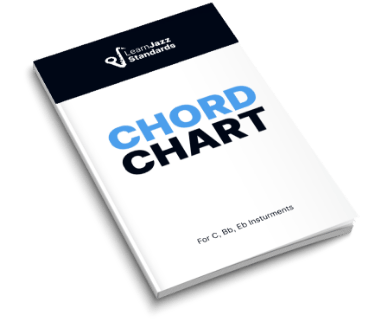If you are ready to take your chord knowledge to the next level and tackle chord inversions, you’ve come to the right place!
We’ll walk you through everything you need to know about inverted chords so that by the end of this article, you’ll learn how to build, cycle through, and voice lead using chord inversions. Here are some topics we’ll talk about—
- What chord inversions are
- How chord inversions work and how to construct them
- Inverted triads and 7th chords
- Common guitar and piano chord inversions
- How to practice chord inversions
- How knowledge of chord inversions helps you comp with strong voice leading
Your music theory knowledge will increase, and you’ll have practical ways of applying what you know when playing and performing music!
If you want to improve your music theory knowledge and playing ability, check out the Learn Jazz Standards Inner Circle. The Inner Circle is designed for musicians who want to seriously improve their musical skills but who don’t know how to break bad practice habits and make steady progress.
With abundant instrument-specific and instrument-agnostic courses, masterclasses, workshops, and jazz-standard deep dives, the Inner Circle is designed to help you break through practice plateaus and take your playing to the next level.
Improve in 30 days or less. Join the Inner Circle.
What is a Chord Inversion?
Many of you reading this are familiar with root position chords. Below, you’ll notice a root position C major chord.
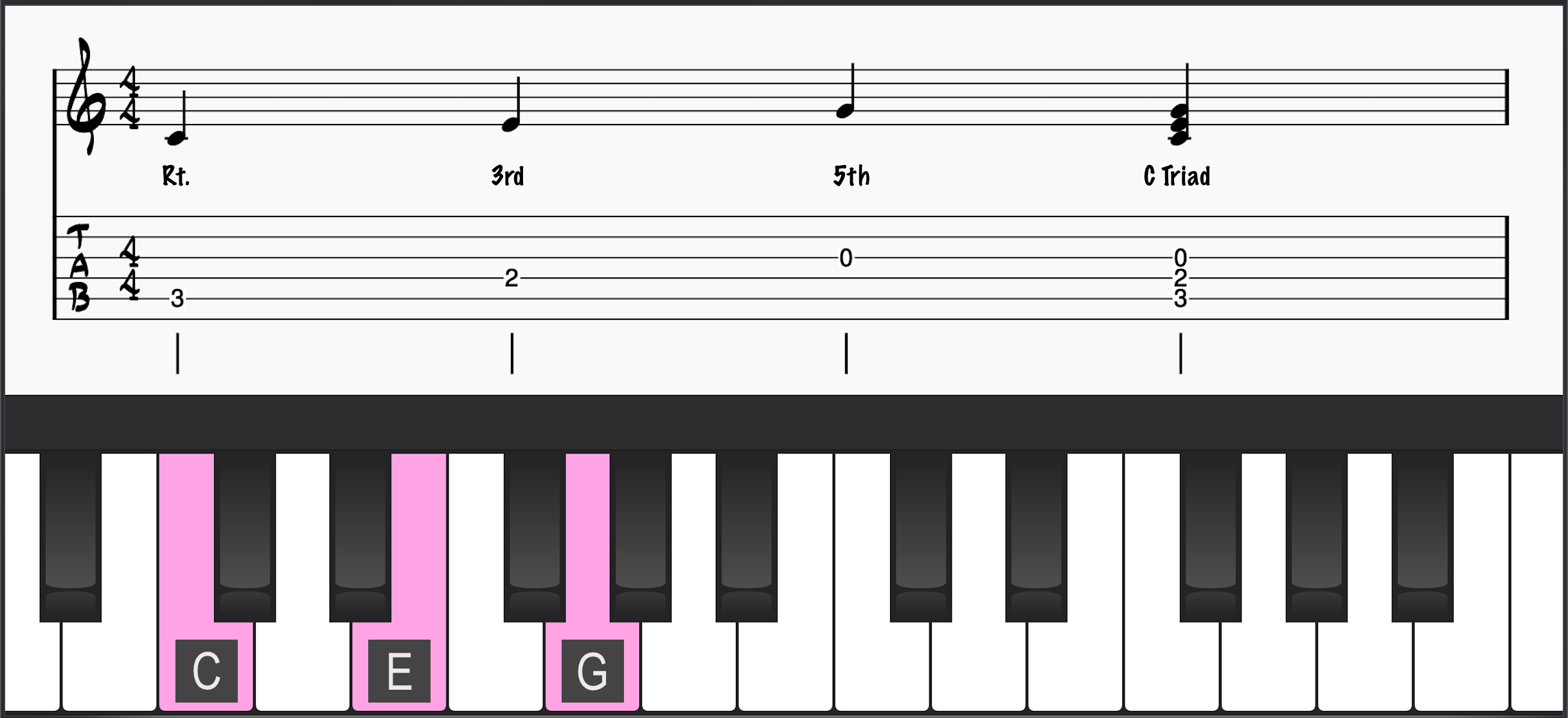
Root-position chords are constructed with the root note (lowest note) on the bottom, the third in the middle, and the fifth (highest note) on top. When you first learn stock chords on the piano, you usually learn chords in root position.
However, things aren’t always so simple out in the musical wild. Sometimes, you’ll be reading a chord chart, and suddenly, you are faced with a D/F#.
For reasons we’ll get to later, the root position of a chord isn’t always the best-sounding, most practical, or even easiest voicing to play—especially in the middle of a chord progression. In order to create the best-sounding, most practical chord progressions, musicians often use chord inversions.
So, what are they, exactly?
It’s quite simple—chord inversions are chords whose root note is not the lowest note. Instead, another chord note (the 3rd, 5th, or 7th) sits on the bottom.
How Guitar And Piano Chord Inversions Work
Let’s use the example of a D/F#. Some of you may be familiar with this chord already. The symbol D/F# tells you two things:
- You need a D major chord
- It needs to have an F# (the 3rd) as its lowest note
A root position D major triad is spelled like this:
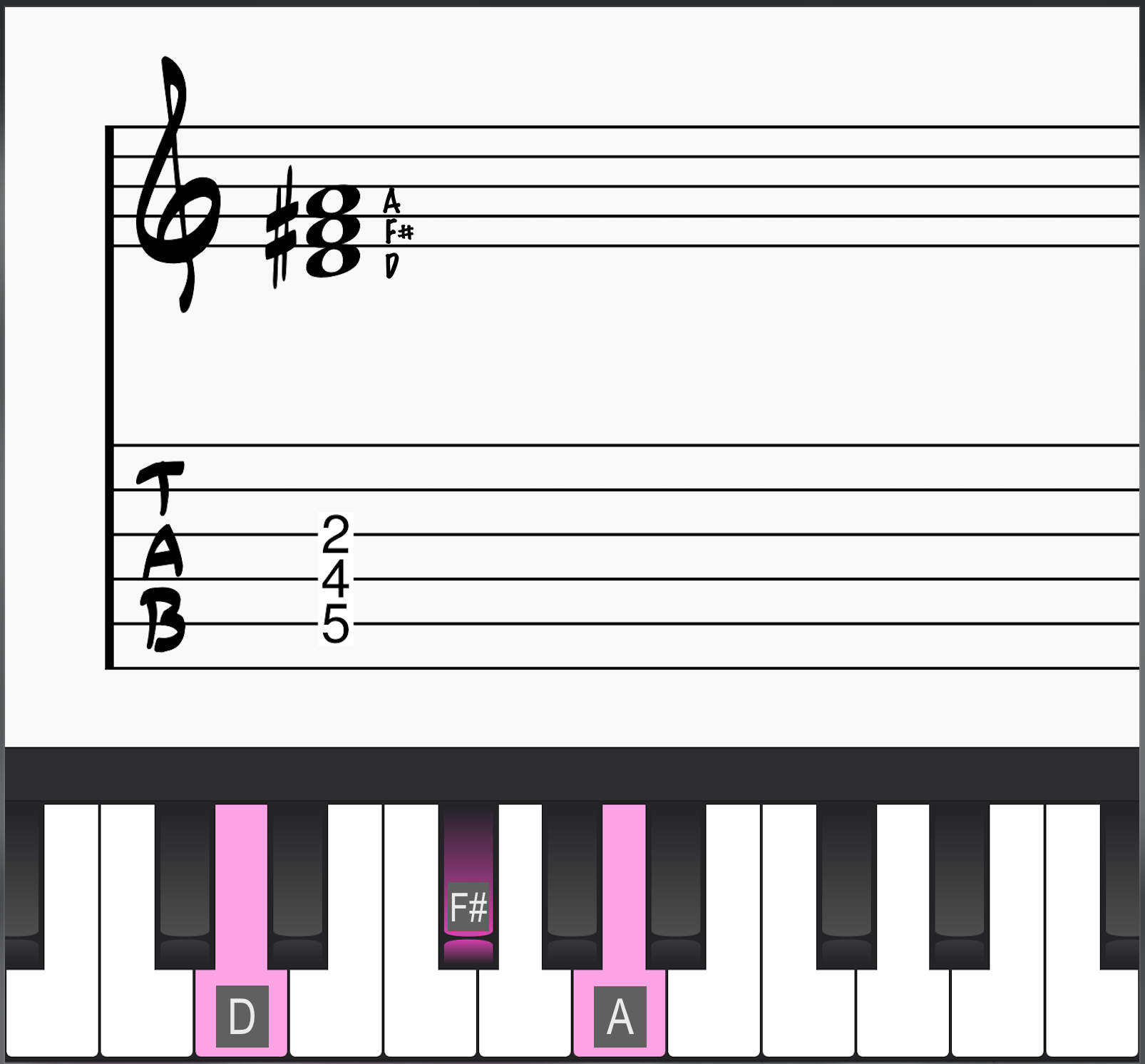
- 5th: A
- 3rd: F#
- Rt: D
To change this root position triad into a D/F#, we need the F# to be the bottom note. The easiest way to do this is to take the D up one octave higher, leaving the F# on the bottom. This is called a first inversion because it is the first time we’ve inverted the chord.
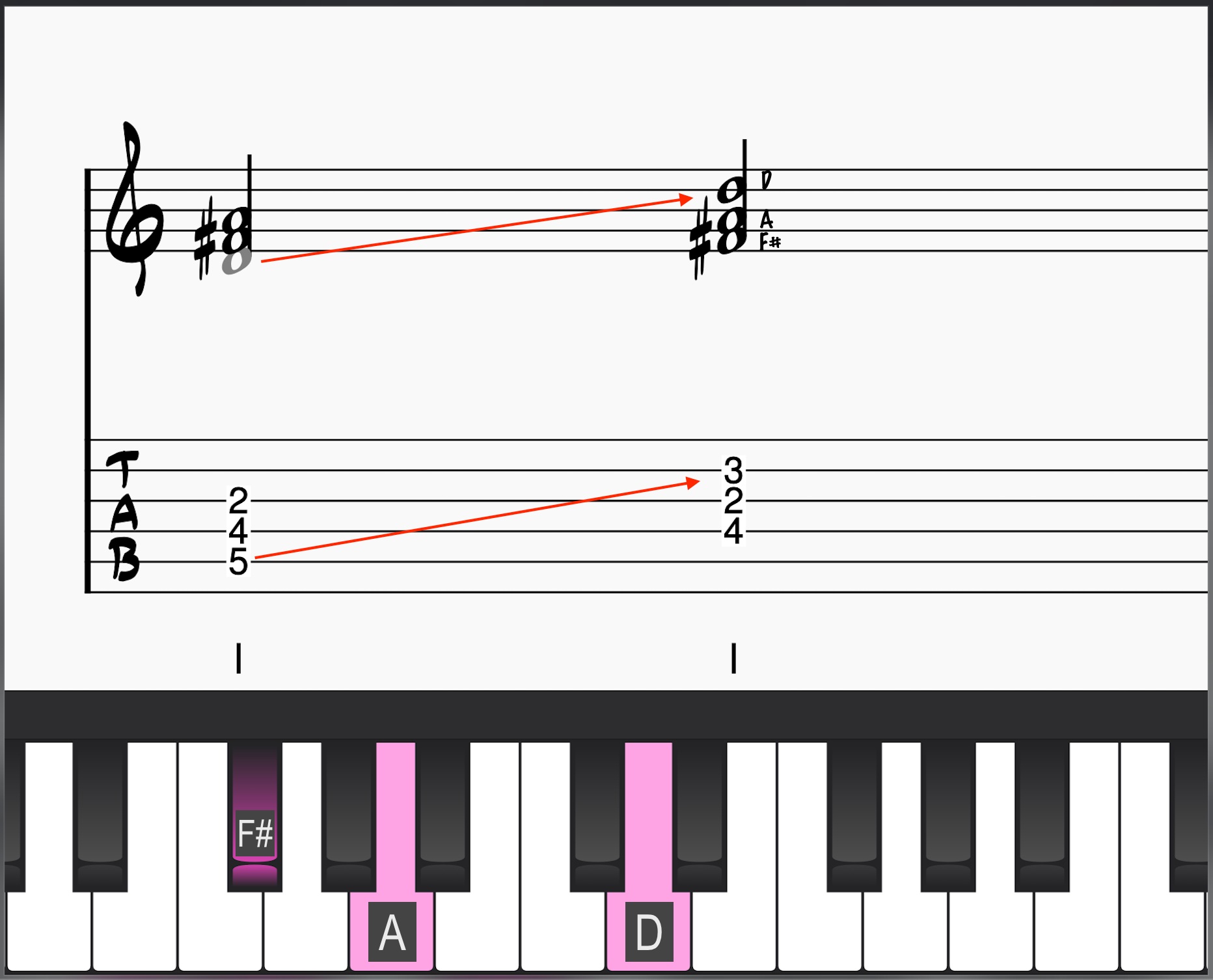
- Rt: D
- 5th: A
- 3rd: F#
Inverted Chord Shapes on Guitar
Many familiar and easy open-position guitar chords are actually complex chords made of smaller inverted triads. These seemingly basic chords actually contain multiple octaves and double certain chord tones, making them complex chords.
Let’s look at the stock open position E major “cowboy chord.”

This is one of the first chords guitar students learn. If you were to learn this chord in music theory first, this chord would be way more advanced than a simple root position E major triad on piano.
This particular E major chord voicing spans two octaves and has several fifths and octaves doubled within it. It also has several chord inversions present within its overall chord shape.
Guitar students aren’t taught to think of chords this way right off the bat, but it’s important to introduce this concept now.
That’s because the guitar’s structure is unique, and this results in some advantages and disadvantages when working with chord inversions. We’ll discuss these advantages and disadvantages using specific examples below, but I wanted to provide a fair warning first!
For more on jazz guitar chords and jazz guitar chord shapes, check out these 20 essential jazz guitar chords.
Now that we know what chord inversions are and what we can expect from them on the guitar and piano, let’s examine all the different kinds of simple inversion chords we can construct.
Inverted Traids
Let’s take one chord—a C major—and move it through all possible chord inversions. Because there are three notes, there are three positions for simple triad inversions.
- Root Position
- 1st Inversion
- 2nd Inversion
Root Position Chords
As we mentioned above, simple root position chords are stacked root, third, and fifth.
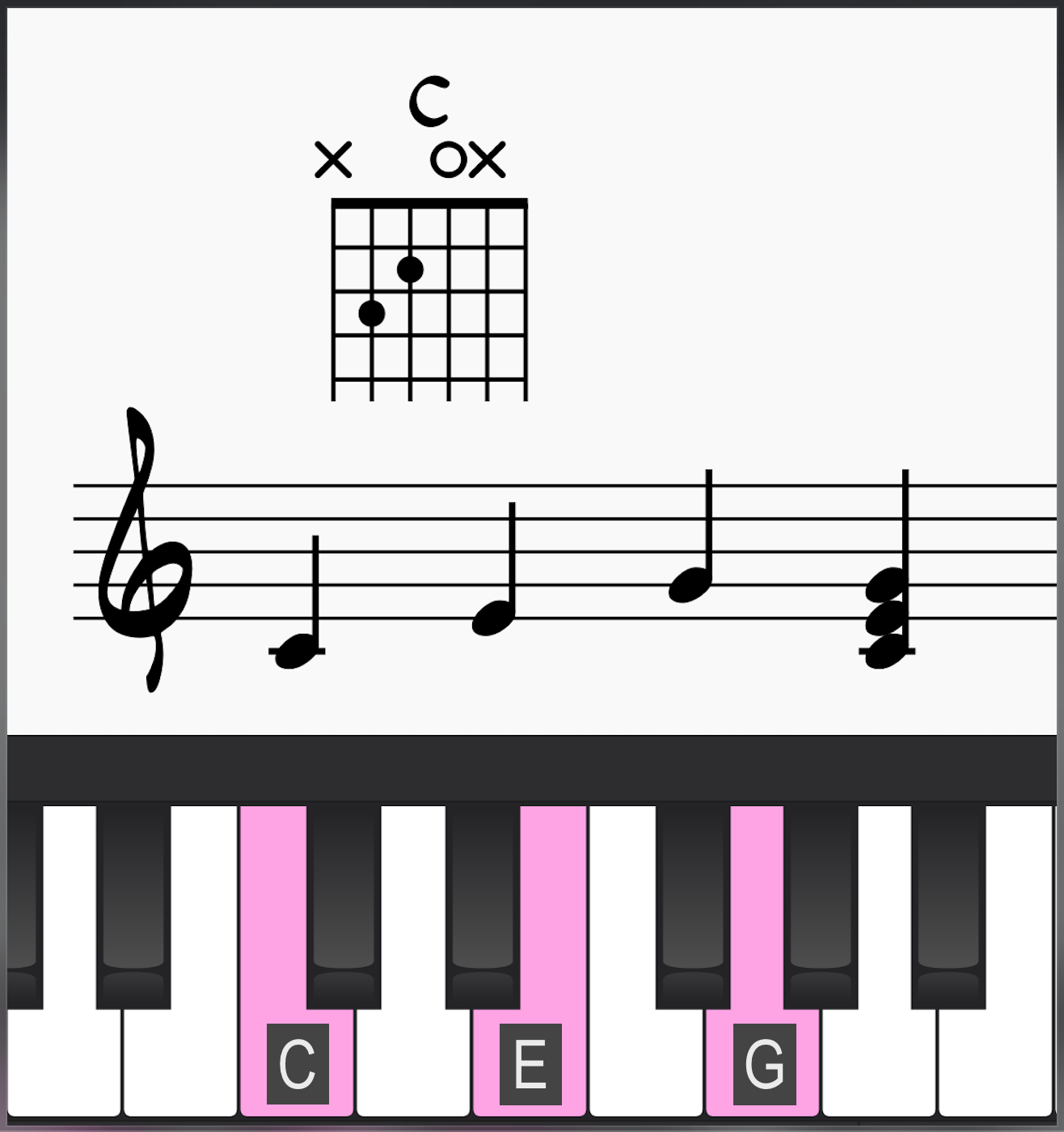
- 5th: G
- 3rd: E
- Rt: C
First Inversion Chords
As we demonstrated with the D/F#, to build a first inversion C major triad, we take the C and move it up an octave, leaving the E at the bottom of the chord.
This makes a C/E chord:
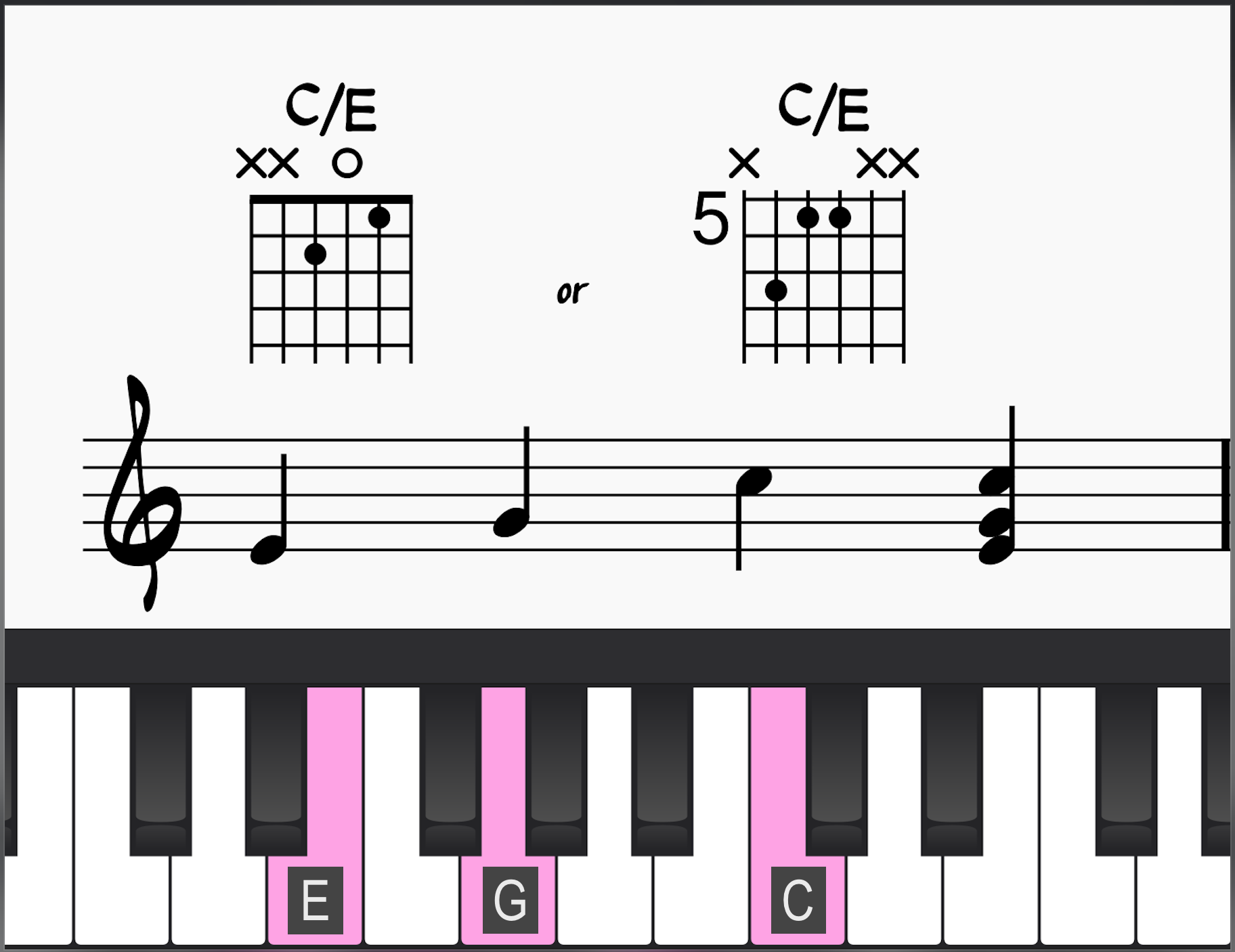
- Rt: C
- 5th: G
- 3rd: E
Notice how the image above shows two guitar chord diagrams. As mentioned before, the guitar’s structure is unique in that the same note exists in multiple places. That means you can play the same chord (in terms of pitch) in different areas on the neck and on other string groups.
I’ve shown this C/E chord in two different areas on the guitar. The first diagram moves the chord across string groups, whereas the second diagram keeps the inversion on the same string group. These are the same chord!
For more on major triad shapes on the guitar, check out our major triad guitar guide.
Second Inversion Chords
If we follow the process to its logical conclusion, a second inversion triad moves the third up an octave to the top of the chord, leaving the fifth at the bottom.
This makes a C/G chord:
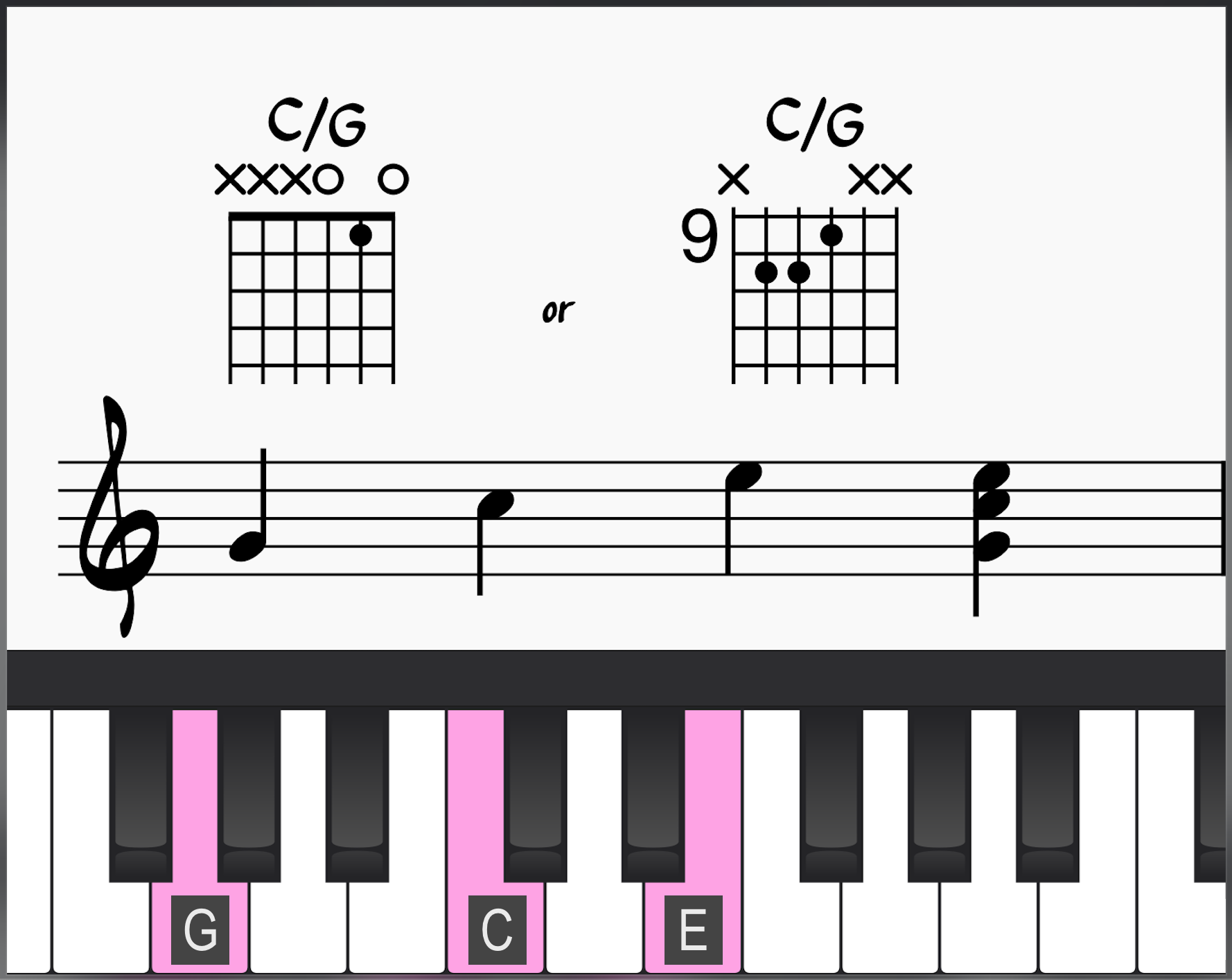
- 3rd: E
- Rt: C
- 5th: G
BEFORE YOU CONTINUE...
If music theory has always seemed confusing to you and you wish someone would make it feel simple, our free guide will help you unlock jazz theory secrets.

Inverted Seventh Chords
Let’s turn our C major triad into a Cmaj7 chord and explore all possible chord inversions. Seventh chords have four notes, so it follows that there are four possible chord variations:
- Root Position
- 1st Inversion
- 2nd Inversion
- 3rd Inversion
Root Position 7th Chords
Like our root position triads, root position seventh chords have the root of the chord as the bass note.
On piano, it is easy to voice all different inversions as the piano keyboard is a linear axis of pitch (left to right, low to high).
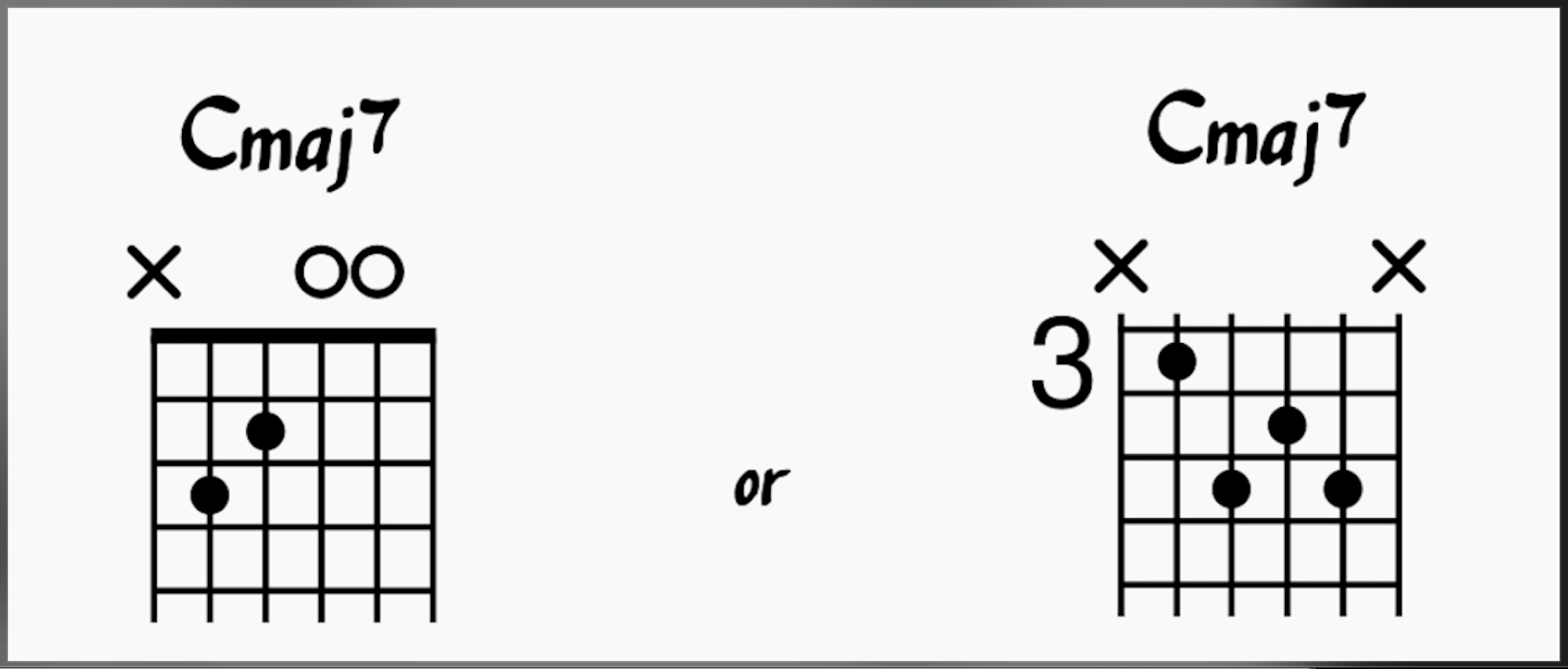
However, things get more complicated when playing the guitar. While it’s possible to voice a Cmaj7 chord in close root position, other inversions are very difficult, if not impossible, to voice in close position. In the second chord chart diagram given, the stack of notes for this root position voicing is:
- 3rd: E
- 7th: B
- 5th: G
- Rt: C
It is not as it would appear on the piano:
- 7th: B
- 5th: G
- 3rd: E
- Rt. C
Because of the guitar’s unique nature, the guitar voicings in the chord diagrams may appear differently than the notation on the staff!
Here is a root position Cmaj7 chord:
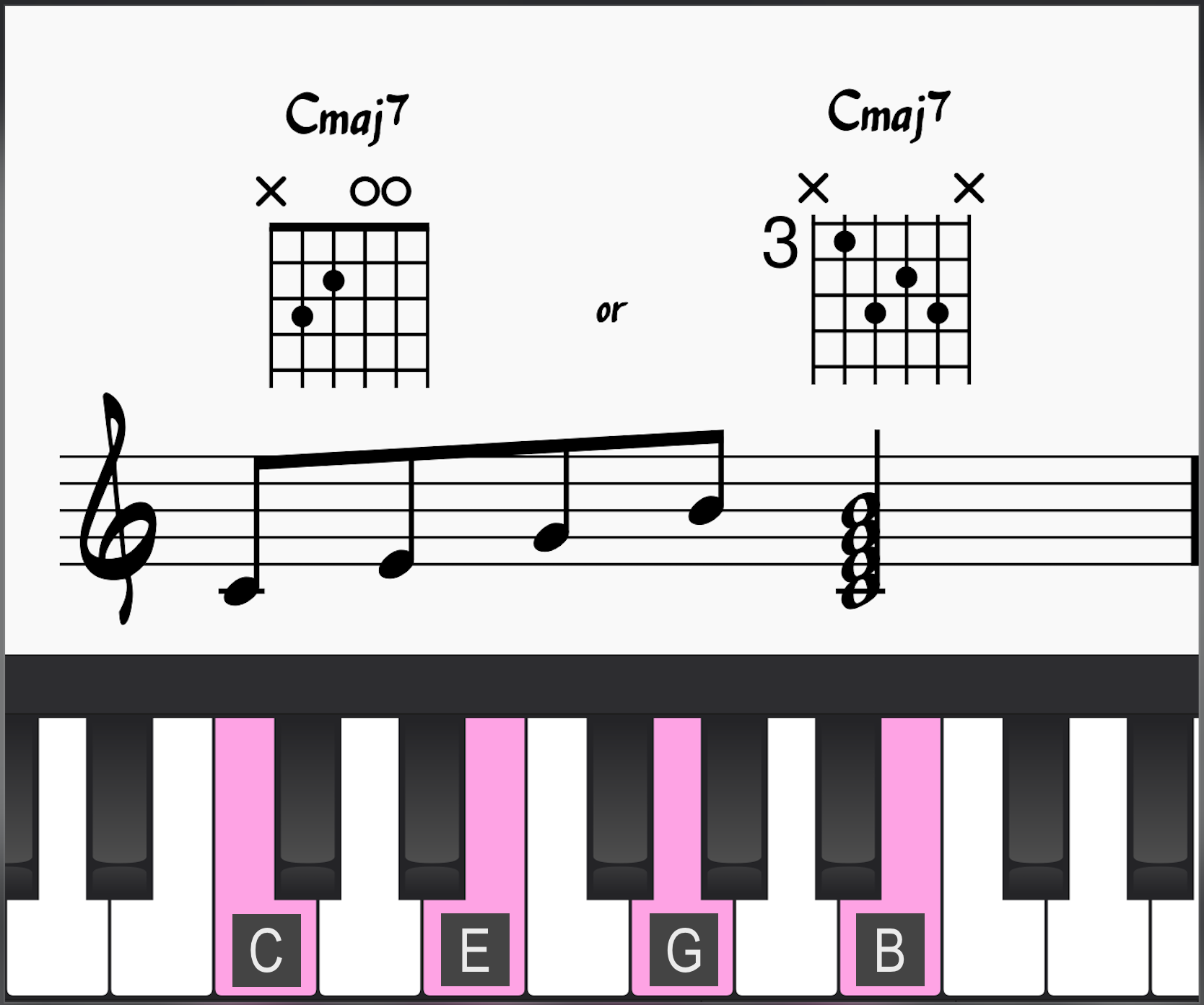
- 7th: B
- 5th: G
- 3rd: E
- Rt: C
First Inversion 7th Chords
Following the same process we used for triads, let’s take the root note (C) and move it to the top of the chord. When we do this, we get a Cmaj7/E chord:
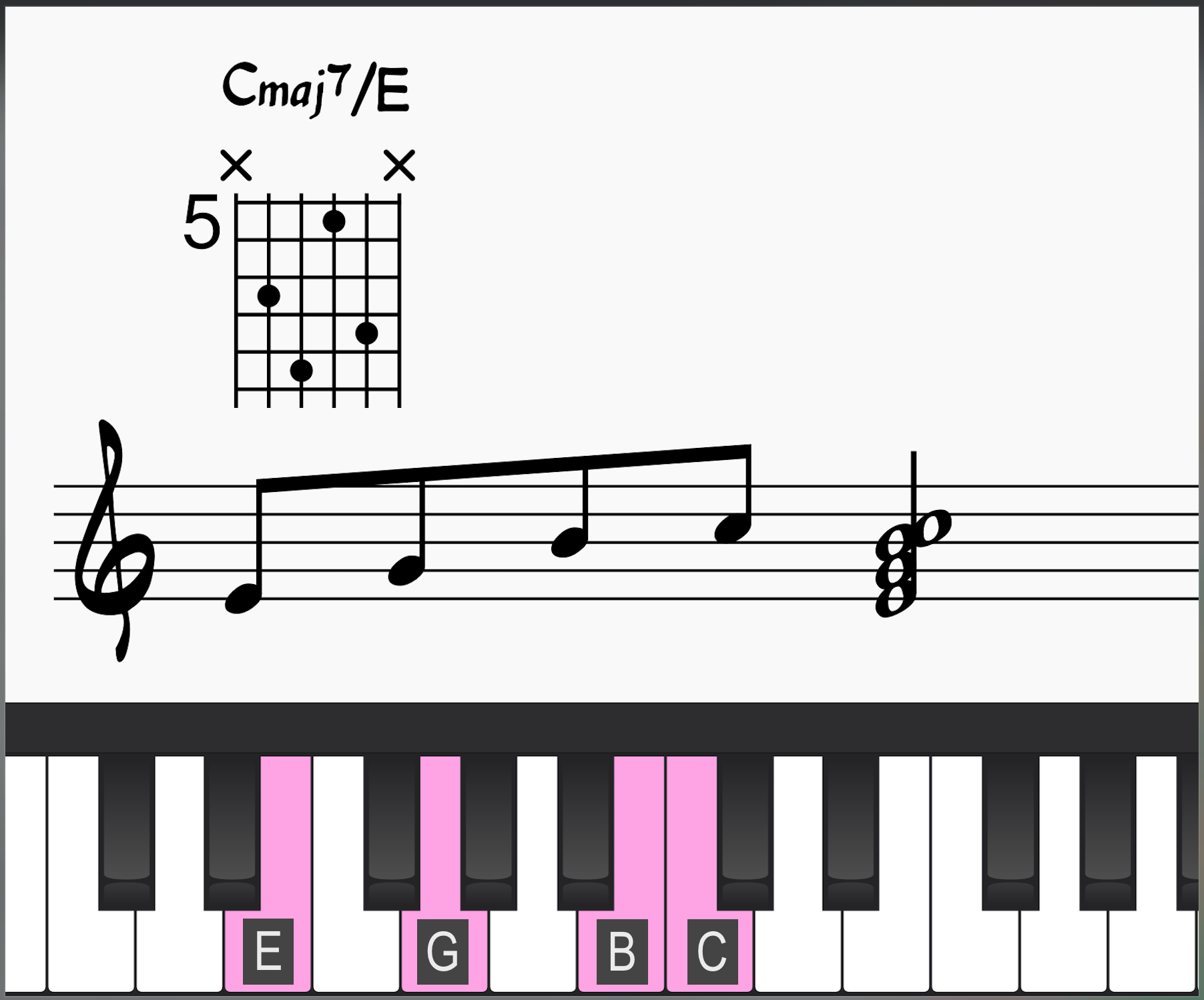
- Rt: C
- 7th: B
- 5th: G
- 3rd: E
This voicing is practically impossible on guitar in close root position, so we inverted the alternate Cmaj7 chord voicing used in the previous example.
Second Inversion 7th Chords
When we move the 3rd of the chord up an octave, we get a second inversion Cmaj7 chord or Cmaj7/G:
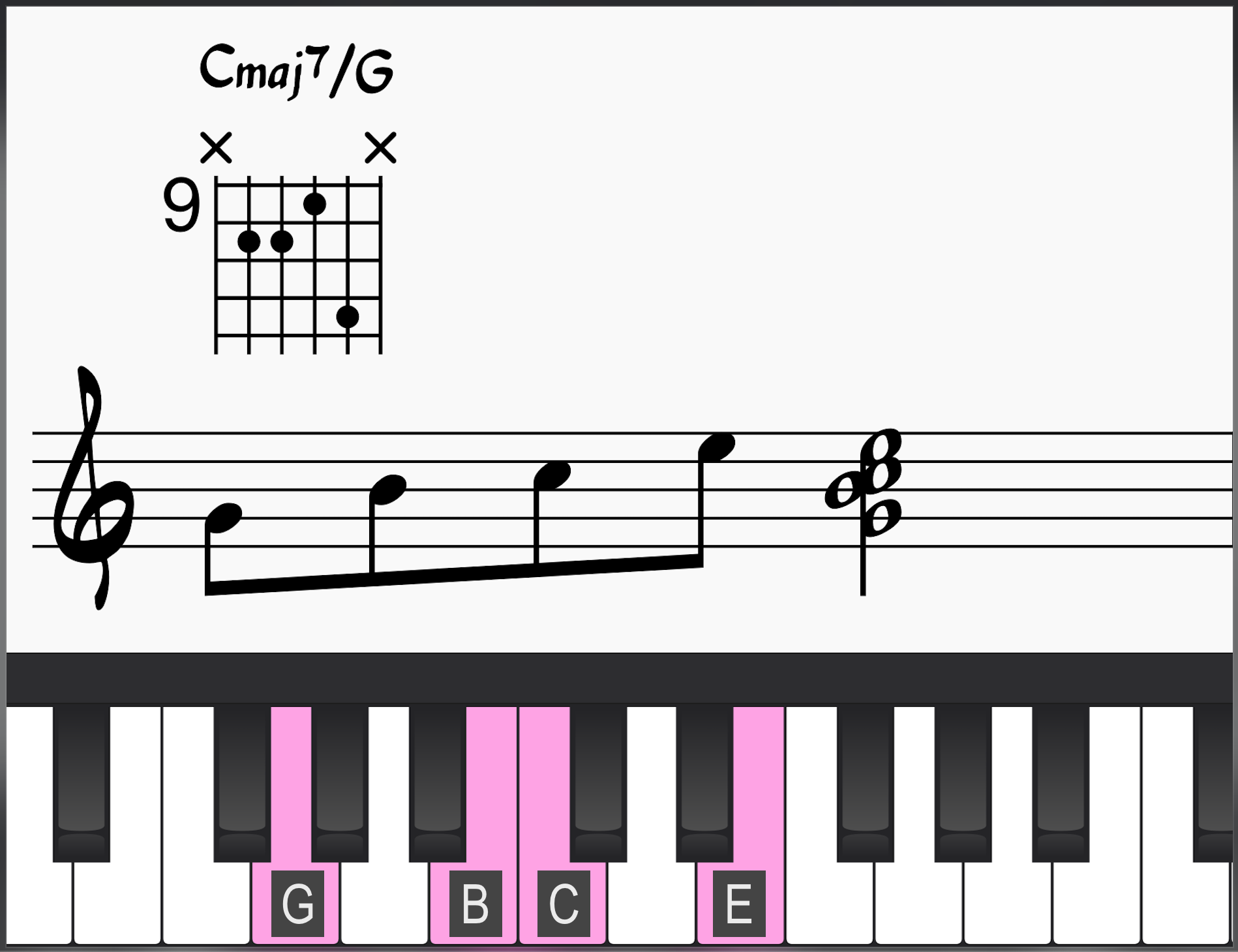
- 3rd: E
- Rt: C
- 7th: B
- 5th: G
Third Inversion 7th Chords
To make a 3rd inversion Cmaj7 chord or Cmaj7/B chord, we take the G and move it up an octave to the top of the chord:
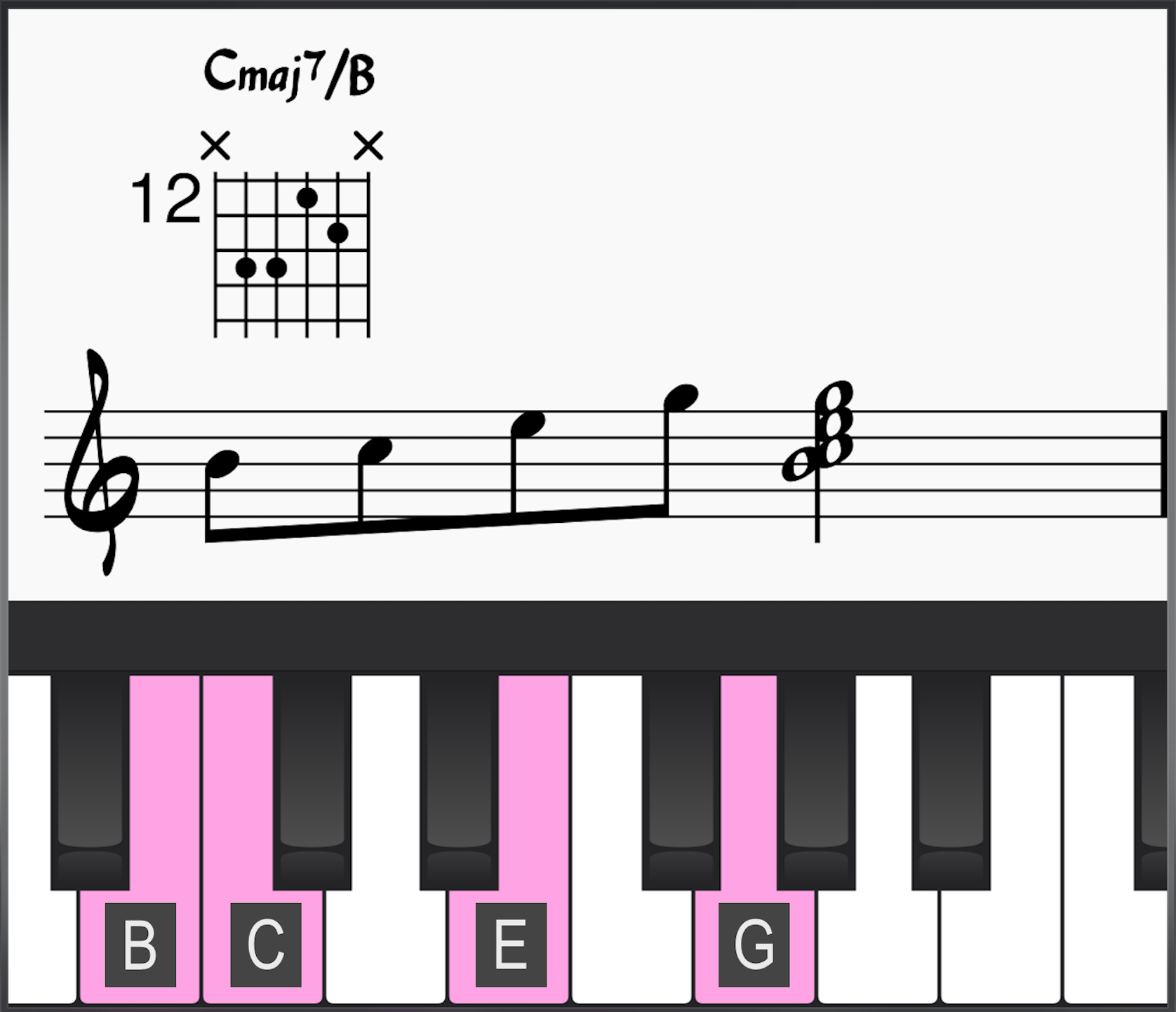
- 5th: G
- 3rd: E
- Rt: C
- 7th: B
For more on 7th chords, check out our ultimate guide to 7th chords. And, if you want piano-specific chord voicings, check out these 15 jazz piano chords.
Why Play Inverted Chords? (…Voice Leading!)
Playing root position chords exclusively leads to chord progressions that sound disjointed.
Each voice moves much further intervallically. Notice how each voice moves up a fourth as we move from a D-7 to a G7. Then, when resolving to the Cmaj7, each voice moves down a fifth.

Listen to the audio to hear how disconnected these voicings sound.
Compare the example above with a ii-V-I using chord inversions below. If we use chord inversions, the voices can move stepwise to form the next chord (if they have to move at all).

This results in a smoother-sounding chord progression because each voice moves in steps, not leaps, and the voicings are much closer together. Be sure to listen for yourself!
In the example above, we started on a root position D-7 chord and moved to a second inversion G7 chord. Check out another example where we start on a second inversion D-7 chord:

Using chord inversions leads to smoother-sounding chord progressions because the voice leading is stronger.
For more on the ii-V-I chord progression, check out our guide to 2-5-1 progressions.
How To Practice Chord Inversions
Now that we know what chord inversions are and why we should use them when playing piano or guitar, let’s discuss ways to practice them.
Play Inverted Chord-Scales with Triads and Seventh Chords
Playing chord scales is a great way to get familiar with chord inversion shapes. Chord scales are exactly what they sound like—harmonized scales.
Here is a harmonized C major scale:

Notice how we start with a Cmaj7 chord, and each note in the chord moves up a scale degree to form the next chord.
- B moves to C, which moves to D, and so on
- G moves to A, which moves to B, and so on
- E moves to F, which moves to G, and so on
- C moves to D, which moves to E, and so on
We can do the exact same thing with chord inversions.
First Inversion C Major Chord Scale

- C moves to D, and so on
- B moves to C, and so on
- G moves to A, and so on
- E moves to F, and so on
Second Inversion C Major Chord Scale

- E moves to F, and so on
- C moves to D, and so on
- B moves to C, and so on
- G moves to A, and so on
Third Inversion C Major Chord Scale

- G moves to A, and so on
- E moves to F, and so on
- C moves to D, and so on
- B moves to C, and so on
You are not limited to the major scale. You should also practice chord scales in all inversions for melodic minor and harmonic minor!
Check out these articles for more on the melodic minor and harmonic minor scales.
Play Chord Progressions But Keep the Voicings in One Area
Another great exercise for chord players is to comp over changes but limit yourself to one area of your instrument. This will test your knowledge of the keyboard or the fretboard and help you practice making changes with inverted chords in time.
Here are the first 8 bars of Autumn Leaves using inverted chords limited to one area of the piano. Try this with the left hand and the right hand:

Check out the chord symbol over each bar for a hint about what kind of inversion each chord is.
For more on Autumn Leaves, check out our article on Autumn Leaves chords.
Take Your Chord Knowledge and Ability to the Next Level. Join The Inner Circle.
If you want to seriously level up your musicianship game but don’t know where to begin, check out the Learn Jazz Standards Inner Circle.
The Inner Circle is designed to help you systematically progress in various aspects of musicianship. From ear training and music theory to jazz improvisation and tune memorization—the Inner Circle will help you break through playing plateaus and become a better jazz musician.
Improve in 30 days or less. Join the Inner Circle.









